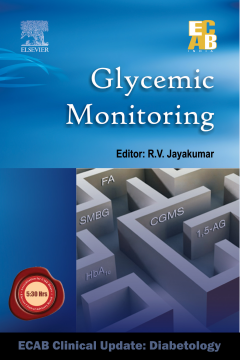
Additional Information
Book Details
Abstract
Diabetes is a chronic disease that is reaching an epidemic proportion in many parts of the world. Despite the high incidence of diabetes, individuals diagnosed with the disorder are only 50%. The main challenge
of medical professionals in diagnosing and treating the diabetic patients is the lack of understanding of the disease, which usually leads to problems with treatment compliance and monitoring.
There is strong evidence to show that an effective intensive glycemic control reduces various microvascular and neuropathic complications of diabetes mellitus. The Diabetes Control and Complications Trial (DCCT) showed that the intensive glycemic control prevented diabetic complications in type 1 diabetic patients, and the HbA1c levels reduced by 1.5–2.0%. In the UKPDS study, a modest improvement in HbA1c (a difference of 0.9 %) in the intensively treated group than in the control group brought about a 25% reduction in microvascular complications and a 12% reduction in all diabetes related events. There are several methods with differing utilities and limitations existing for monitoring glycemic status in individuals.
Diabetes care in India leaves much to be desired and suggested, and there is a need for efforts to increase awareness of both the patients and the doctors for better treatment and monitoring.
Table of Contents
| Section Title | Page | Action | Price |
|---|---|---|---|
| Front Cover | Front Cover | ||
| Front Matter | ia | ||
| Copyright | id | ||
| ECAB Clinical Update:Diabetology | ie | ||
| Glycemic Monitoring | if | ||
| About the Authors | ig | ||
| Contents | ii | ||
| ECAB Clinical Update InformationGLYCEMIC MONITORING | i | ||
| Preface | v | ||
| Relative Role of Various Parameters of Glycemic Monitoring in Indians | 1a | ||
| ABSTRACT | 1a | ||
| KEYWORDS | 1a | ||
| Introduction | 1a | ||
| Global Update | 1a | ||
| Update in Indian Context | 2 | ||
| History of Diabetes in India | 2 | ||
| Burden of Diabetes in India | 5 | ||
| Personal clinical experience and management | 5 | ||
| Self-Monitoring of Blood Glucose | 6 | ||
| Aim | 7 | ||
| Advantages | 7 | ||
| Disadvantages | 8 | ||
| The Conditions Where SMBG is Not Possible | 8 | ||
| Indications | 8 | ||
| Conditions Where Strict Glycemic Control is Not Desirable | 9 | ||
| Frequency of Monitoring | 9 | ||
| In Type 1 DM Patients Who are on Intensive Therapy | 10 | ||
| During Pregnancy | 10 | ||
| In Type 2 Diabetes Mellitus | 10 | ||
| Conditions Requiring Frequent SMBG | 10 | ||
| The Method of Measurement of Blood Sugar by Blood Sugar Meter | 10 | ||
| Changes Made in the New Blood Sugar Meters | 11 | ||
| Blood Sugar Estimated by Blood Sugar Meter and Conventional Method (Laboratory Estimation) | 11 | ||
| Need of Blood Sugar Meter | 12 | ||
| SMBG by Blood Sugar Meter vs. Matched Strip | 12 | ||
| Factors Influencing the Results of SMBG by Blood Sugar Meter17-19 | 12 | ||
| Noninvasive Methods of SMBG | 12 | ||
| Urine examination | 13 | ||
| Quantitative Analysis of Urine Glucose | 16 | ||
| Urine Ketone Examination | 16 | ||
| Tests for Urine Ketone Determination | 16 | ||
| Indications of Testing for Ketonuria | 17 | ||
| Serum 1,5-Anhydroglucitol | 18 | ||
| Blood Sugar Measurement | 18 | ||
| Measures of Long-Term Control | 18 | ||
| Glycation of Hemoglobin | 19 | ||
| Nomenclature | 19 | ||
| Glycated Hb in Nondiabetic Persons | 20 | ||
| Glycated Hb in Patients with Diabetes | 20 | ||
| Interpretation of Antecedent Glycemia from HbA1c | 20 | ||
| Glycated Hb and Chronic Complications in Diabetes | 22 | ||
| Assay Methods of Glycated Hemoglobin | 22 | ||
| Frequency of Testing HbA1c | 23 | ||
| Factors Affecting the Results of HbA1c | 23 | ||
| A1c Goals as per ADA Recommendation 2008 (Tables 3-6)34 | 23 | ||
| Key Concepts in Setting Glycemic Goals | 23 | ||
| Fructosamine and Glycated Serum Proteins | 24 | ||
| Indianized Guidelines for Monitoring | 25 | ||
| Laboratory Assessment | 25 | ||
| Follow-up Evaluation35 | 26 | ||
| Yearly Investigations | 27 | ||
| ICMR Guidelines | 27 | ||
| Conclusion | 28 | ||
| Case Studies Relative Role of Various Parameters of Glycemic Monitoring in Indians | 33 | ||
| Case study 1 | 33 | ||
| Learning Lessons | 34 | ||
| Case study 2 | 34 | ||
| Learning Lessons | 35 | ||
| Case study 3 | 35 | ||
| Learning Lessons | 36 | ||
| Nonglycemic Parameters of Glycemic Monitoring in Diabetes | 37a | ||
| ABSTRACT | 37a | ||
| Socioeconomic Aspects of Glycemic Monitoring | 52a | ||
| Summary | 71 | ||
| Other Books in This Series | 72 | ||
| DIABETES IN PREGNANCY | 72 | ||
| PREDIABETES | 72 | ||
| INFECTIONS IN DIABETES | 73 | ||
| DIETARY CONSIDERATIONS INDIABETES | 75 | ||
| CARDIOMETABOLIC RISK IN INDIA | 75 |
